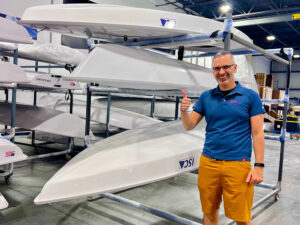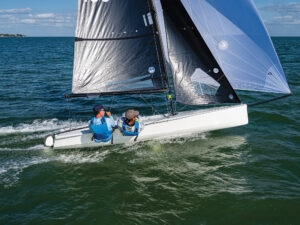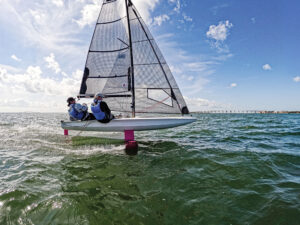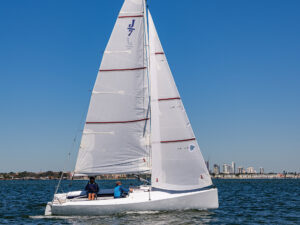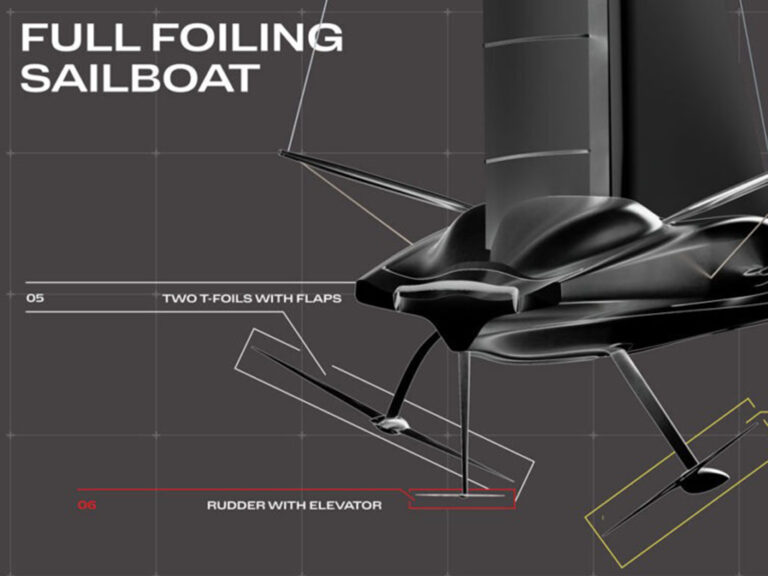
RS Feva
When I was a kid I loved when our club’s junior weeknight racing was called off because there was too much wind. My crew and I would hop on our BMX bikes and blast across town to his aunt’s house where his dad stored his Laser 2. Never bothering to tell any adult what we were up to, we’d rig it, roll it down the street, launch it, and spend an hour or two jib reaching back and forth across the bay. We’d laugh our asses off the entire time, having the time our lives careening across wave tops, occasionally stuffing the bow and capsizing. I thought about those times this past spring while launching the RS Feva XL into a vacant Newport Harbor for our test sail. The thought was sparked by a comment made minutes earlier by Ned Jones, Vanguard Sailboat’s marketing guy: “The boat, we think, will keep kids excited about sailing.” Those windy reaches will always be what kept me excited about sailing when I was young, and I wondered whether the Feva would’ve, too. First, a little background on the boat: Vanguard Sailboats, which has an extensive line of fiberglass racing dinghies, from the Optimist and Laser right on up to the 49er, is importing the Feva from LDC Sailboats in England. Vanguard is looking to fill the same post-Opti sailing niche that prompted Bruce Kirby to design the Pixel (see, “Meet The Pixel, Bruce Kirby’s Latest,” Feb. ’05). Vanguard will primarily promote it among public and private sailing clubs, camps-wherever kids and water mix. If one-design racing comes as a byproduct, then all the better, says Jones. This approach ha s been successful in Europe, where LDC first launched the boat as a recreational replacement to the doublehanded and “outdated” Cadet and Mirror dinghies. In two years, the boat has caught on far beyond LDC’s expectations. “They’re going out the door as fast as we can make them,” says Jon Partridge, LDC’s Feva Development Director. Feeding the Feva’s success is the Royal Yachting Association (England’s equivalent to US SAILING) selection of it as its official youth trainer. The RYA has even collaborated on a program with LDC (covering 50 percent of the costs) to get Fevas into the hands of public sailing facilities in England to lure non-sailing families off the streets and onto the water. Nearly 1,000 have been built and 50 boats are expected at the Feva European Nationals this summer. Partridge says the class is expecting ISAF recognition in November. Our First Impressions My initial hang-up with the Feva was that it’s plastic-technically, rotomolded polyethylene-and I stand with most racing sailors in the belief that when it comes to performance, rotomolded plastic doesn’t come close to fiberglass. That’s mainly because in order to get any strength and durability, rotomolded boats must be overbuilt. The Feva is no exception. Its hull is 2 feet shorter than a Laser hull, but weighs about 9 pounds more (the Feva’s bare hull weighs 139). But again Jones reminded me that it’s strictly a “recreational” boat, so considering the abuse it can withstand, and its $4,995 price tag, 9 pounds is a small price to pay. “OK, fair enough,” I tell myself. “Ignore the fact that it’s plastic and see how it goes.” When standing alongside the boat, the Feva looked small, mainly because of its shallow, self-draining cockpit and short (low-aspect) sailplan, but once sailing, it was much more comfortable than I thought it would possibly be. At 5’10”, my knees weren’t pinned to my chest, and the side decks were wide enough to hike comfortably. There are molded foot chocks on the floor and separate hiking straps for skipper and crew. Forward, near the flush centerboard trunk, space is tight for an adult, but a young, agile 120-pounder will find it perfectly comfortable. The boom is set high, so getting under the vang while tacking and jibing was never an issue. For our test sail we had two “fat guys” (myself and Jones, about 170 pounds apiece) and the Feva is a boat for youth sailors (or one adult and flyweight child) so we were definitely holding it back, but once we launched the asymmetric, and set off on a reach in a 10-knot puff, the foils hummed and the hard-chine hull nearly popped up on a plane. With 100 pounds less bodyweight and 15 more knots on the tail, it’s easy to imagine how much fun that first plane would have been. Upwind, the boat responded to puffs with an immediate heel, but a hard hike and a slight bearaway was enough to flatten it quickly and accelerate. We did have an issue with excessive weather helm when sailing through puffs, but in the lulls the helm was light and lively. Without a doubt, the boat must be sailed flat to eliminate the tug of the tiller. A continuous spinnaker halyard, which simultaneously launches and extends the bow pole, allows the spinnaker to go up and down easily with three or four pulls. At 76 square feet, it’s 19 square feet smaller than a 420 spinnaker so any pint-sized sailor should be able to handle it when it’s windy. The kite is short footed, so it’s forgiving and extremely easy to jibe. Ease of righting is a concern with any youth boat and this is addressed with righting lines threaded along the underside of the rails, which like a catamaran righting line, gives the operator something to leverage against when standing on the centerboard or the leeward rail. The boat’s foam core gives it a lot of buoyancy and the rig is short, so it should be easy for a lightweight junior to right it. The overall concept of the boat is simplicity, and to this end the Feva is simple to rig. A two-part, spreaderless aluminum mast is stepped “Iwo Jima” style by inserting the butt in its shoe, pushing the mast forward and up, and locking a collar behind it. Two shrouds, which Jones says “really only keep the mast from pulling forward when the spinnaker’s up,” are set with pins and ring dings, and the main and jib go up on external halyards (the main has a mast track). The asymmetric spinnaker’s halyard/belly line (for sucking the spinnaker into the opening in the bow) can be left attached if the boat resides in its dolly. The vang, outhaul, and cunningham controls are much like the now “old-style” Laser controls and are easy to set up. It’s worth noting that the boat we sailed is the most basic version of the XL but upgrade options are available. We’d splurge for a mainsheet ratchet block in a heartbeat, and then the 6-to-1 vang. So, back to my original thought: if the Feva XL had been sitting at my crew’s aunt’s house 20 years ago would my buddy and I have jumped in it at any opportunity to just go get wet? Absolutely. It has the makings of what we would have wanted-a fast boat that isn’t the least bit intimidating. It would’ve been all the reason to just go have fun and having fun, is the point, is it not? Feva RS XL LOA 12′ Beam 4’8″ Hull weight 139 lbs. SA 79 sq. ft. Spinnaker 73 sq. ft. Price $4,995 www.teamvanguard.com, www.ldcracingsailboats.co.uk

